Petroleum 30 C
Infestation of spider mites and whitefly on young lemon and mandarin trees, as
well as almonds and figs
The young trees of Ms M are overwintered in a cool, light place. Here they
regularly become infested with spider mites and whitefly in February or March.
This year they were treated daily with
Petroleum
30 C (12 pellets in 5 liters water), sprayed and watered. Improvement was seen
after 3 days, and after one week the pests had disappeared. The pots were later
returned to the balcony where they suffered no further infestation.
Petroleum 30 C: Spider mites on greenhouse cucumbers
Ms S. had sixcucumbers in her greenhouse this year. She planted
them, pre-grown in pots, at the end of April . By May she already had her first
cucumbers. As every year, they developed well until they were affected by spider
mites in June.
The affected leaves had yellow spots, caused by the
sucking action of the pests, which later became larger, until finally the entire
leaf dried out and turned brown.
In previous years, Ms S. had used beneficial
organisms (green lacewings). This somewhat reduced the infestation but without
completely eliminating it.
This year Ms S. treated the cucumbers with a
mixture of Petroleum
30 C and Psorinum
200 C, which she applied to the plants every 4 to 5 days, watering and
spraying a total of 3 applications. read
on...
The spider mite infestation improved a little but then
returned strongly again. At this stage the cucumber plants looked distinctly
unwell.
At the beginning of August, she tried Amblyseius
6 X, which is a homeopathic preparation from Gamasina mites.
She
removed the old affected leaves and watered the cucumbers 2x per week with 10 ml
of remedy solution in 10 litres of water.
To her astonishment, the cucumbers
developed new shoots, with healthy leaves and fruit, right through to the end of
September – completely free of spider mites. In previous years the cucumber
plants were finshed already in August. (Edda S., Schwaigern 2013) 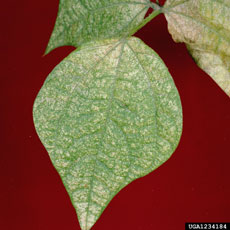
Petroleum: Eradication of Spider Mites on Hibiscus
"I had great success treating a hibiscus (house plant, not frost-hardy) with Petroleum 30 C. The plant reacted immediately – by the next day (!) it had started to differentiate between diseased leaves, which it discarded, and healthy “to be kept” leaves. The plant's vitality increased straight away. The colour changed within a few days, with more green leaves visible. After repotting as an additional measure, it is now putting out new shoots.
For me this is clearly a success application of your homeopathic remedy. Normally I have to take immediate and firm counter-measures in cases of spider mite infestation (which hibiscus is sadly prone to), either by carefully wiping the leaves by hand or by using an insecticide. Inaction leads to the most severe infestation with total loss of leaves."
Initial condition on 8th April :
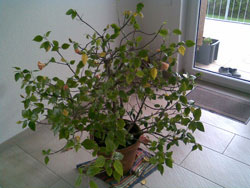
Condition on 10th April (second day after homeopathic treatment) : 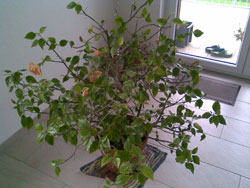
Current condition (6th May) – it was repotted just before Easter
(Good Friday) : 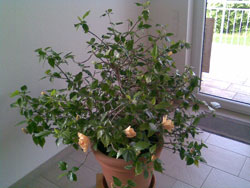
Riccarda L., 2014
 » Petroleum order » Petroleum order
Amblyseius: Spider mites on greenhouse cucumbers
Ms S. had sixcucumbers in her greenhouse this year. She planted them, pre-grown in pots, at the end of April . By May she already had her first cucumbers. As every year, they developed well until they were affected by spider mites in June.
The affected leaves had yellow spots, caused by the sucking action of the pests, which later became larger, until finally the entire leaf dried out and turned brown.
In previous years, Ms S. had used beneficial organisms (green lacewings). This somewhat reduced the infestation but without completely eliminating it.
This year Ms S. treated the cucumbers with a mixture of Petroleum 30 C and Psorinum 200 C, which she applied to the plants every 4 to 5 days, watering and spraying a total of 3 applications. read on...
The spider mite infestation improved a little but then returned strongly again. At this stage the cucumber plants looked distinctly unwell.
At the beginning of August, she tried Amblyseius 6 X, which is a homeopathic preparation from Gamasina mites.
She removed the old affected leaves and watered the cucumbers 2x per week with 10 ml of remedy solution in 10 litres of water.
To her astonishment, the cucumbers developed new shoots, with healthy leaves and fruit, right through to the end of September – completely free of spider mites. In previous years the cucumber plants were finshed already in August. (Edda S., Schwaigern 2013)
Amblyseius 6D: white mites
Treatment date: |
June 6, 2010 |
Pflant: |
Yew, box, juniper |
Location: |
Garden |
Problem: |
Infestation of white mites |
Analysis: |
Amblyseius D6 |
Treatment: |
Watered with a solution of 15 ml in 15 L water |
Result: |
June 12: yew - no further infestation, yellow needles and branches cut back; box and juniper still slightly affected
June 27: no further infestation |

Yew no further infestation |
 |
Box no further infestation |
 |
Juniper no further infestation - new fresh sprout shoots |
Amblyseius 6: white spider mites on apple tree
Treatment date: |
June 12, 2010 |
Plant: |
Apple tree, kitchen window |
Location: |
Lot 76 |
Problem: |
Infestation of white spider mites |
Analysis: |
Amblyseius D6 |
Treatment: |
Watered and sprayed with 10 ml in 10 L water |
Result: |
June 13: spiderweb could not be removed with a strong water jet |
| |
June 27: infestation halted; no further webs; no further spread to other trees |
 |
 |
| Apple tree with infestation |
Apple tree with infestation |
 |
| No further infestation |
 » Amblyseius (predatory mites) order » Amblyseius (predatory mites) order
Psorinum 200 C Spider mites on blackberries:
Blackberry plant is wasting and has pale
leaves. After a single treatment (spraying and watering) with Psorinum 200 C,
it recovered and is producing new leaves that are not infested.
Blackberries, planted in spring, good growth, but then
growth stopped, and they became infested with spider mites.
Treated on June 25 with
Psorinum 200 C (sprayed and watered)
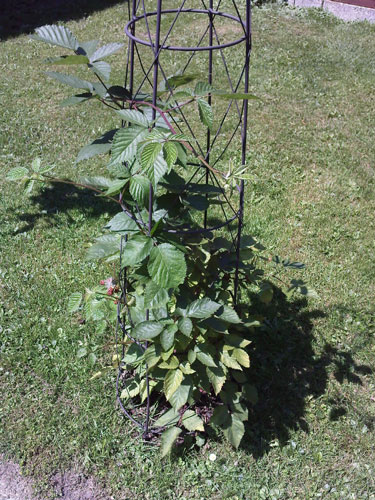
Today (July 7) there are no further signs (except that
the leaves remain pale) and the plant is once again continuing to grow. The silver on the edge of the
leaves is just the hairs of the blackberry.


Psorinum: Spider mites on greenhouse cucumbers
Ms S. had sixcucumbers in her greenhouse this year. She planted them, pre-grown in pots, at the end of April . By May she already had her first cucumbers. As every year, they developed well until they were affected by spider mites in June.
The affected leaves had yellow spots, caused by the sucking action of the pests, which later became larger, until finally the entire leaf dried out and turned brown.
In previous years, Ms S. had used beneficial organisms (green lacewings). This somewhat reduced the infestation but without completely eliminating it.
This year Ms S. treated the cucumbers with a mixture of Petroleum 30 C and Psorinum 200 C, which she applied to the plants every 4 to 5 days, watering and spraying a total of 3 applications. read on...
The spider mite infestation improved a little but then returned strongly again. At this stage the cucumber plants looked distinctly unwell.
At the beginning of August, she tried Amblyseius 6 X, which is a homeopathic preparation from Gamasina mites.
She removed the old affected leaves and watered the cucumbers 2x per week with 10 ml of remedy solution in 10 litres of water.
To her astonishment, the cucumbers developed new shoots, with healthy leaves and fruit, right through to the end of September – completely free of spider mites. In previous years the cucumber plants were finshed already in August. (Edda S., Schwaigern 2013)
 » Psorinum order » Psorinum order
Silicea 6 D + Natrium sulph. 6 D : spider mites on
cucumbers
Cucumbers
were infested with spider mites. The severely infested leaves were removed and
the plants were watered every 5-7 days with Natrium
sulphuricum 6 D and Silicea 6 D,
until there was a noticeable improvement. The roots developed better then ever
before and the cucumbers tasted excellent.
Möcheln, 2012
 » Silicea order » Silicea order
|







![]() » Amblyseius (predatory mites) order
» Amblyseius (predatory mites) order
 Psorinum
Psorinum


 Silicea
Silicea










